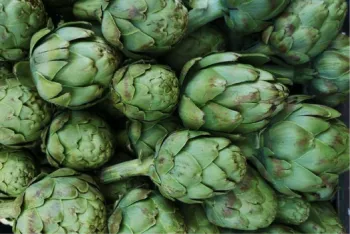Scientific Name
Cynara scolymus
General Information

Perennial, cool-season edible flower. Grows three to four feet tall and wide. Thrives in Marin's coastal climate, where it can produce two crops of tender flower buds a year for five plus years. Large silver-gray leaves make a nice ornamental landscape plant. Likely originates from northern Africa/southern Europe.
When to Plant
Most commonly grown from rooted offshoots or divided plants in early fall. From seed, start eight to 12 weeks before planting outside. In warmer climates, plant outdoors between September and December. In cooler climates, the planting date may be extended to January through March.
Planting
Selecting a site: Artichokes do best in frost-free areas with cool, foggy summers. Freezing temperatures kill the buds, and hot, dry conditions destroy their tenderness. Choose a weed-free area with at least six hours of direct sun. Add lots of compost, organic matter, and/or aged manure. Plant a divided root six to eight inches down (or plant seedling at soil level) and space plants three feet apart. In colder locations, mulch heavily in winter to protect growing plant. A new development for artichokes is growing them as annuals in climates that aren’t typically ideal (areas with hot summers and cold winters).
Soil Requirements
Plant in organic, nitrogen-rich, well-drained soil.
Water Requirements
Water consistently during the growing seasons (early spring and early fall).
Fertilizing
Add a healthy dose or two of nitrogen-rich fertilizer/compost during the growing seasons (early spring and early fall). Use compost as a mulch to nutrify the soil and hold in moisture.
Pollination
Pollinated by bees if buds are left to bloom.
Harvesting
Harvest the bud just as the tips of the lower bracts begin to lift away from the bud, together with two to three inches of stem. This length of stem is usually tender and edible. Don’t delay. The closer to bloom, the tougher they get. After late spring harvest, cut plant back to ground just below the soil level and reduce watering to promote summer dormancy. After several weeks, resume watering. Plants rebound for a fall/winter crop. If planting as an annual, harvest winter through spring and cut down in summer.
Storage
Eat fresh, store in a plastic bag in the refrigerator for three to five days, or cook and freeze.
Good Varieties for Marin
- 'Green Globe'
- 'Green Globe Improved' -- coastal, flowers early summer, goes dormant in hot dry summers
- 'Violetto di Romagna' -- coastal, purple, flowers later than 'Green Globe'
- 'Imperial Star' -- good for areas too cold to overwinter the plants or for growing as annuals
Helpful Tips
Try harvesting some buds when small and immature – when bracts are tightly closed – as tender baby artichokes. During the growing seasons, consider a monthly application of liquid fertilizer to help maximize two harvests.
To prune, cut the entire plant down to, or slightly below, soil level after the spring production peak. Then reduce or withhold irrigation for several weeks. This allows for a summer dormancy. Once you resume irrigation, it encourages rapid and vigorous regrowth of leaves and shortly thereafter, new stems bearing new buds will develop for the fall production period.
Common Problems
Artichokes can be sensitive to too much or too little soil moisture, resulting in stunted buds or rotted roots. Artichokes left on the plant too long will be tough and have a bitter, pungent taste. If you’re late to harvest, consider leaving buds on the plant to visually enjoy their blooms.
Pests- Diseases & More
Artichoke plume moth: If you see dark trails left by larvae as they eat into the buds, consider cutting down plant and then growing as an annual to reduce overwintering moths. Aphids, ants, earwigs, slugs, and snails can bother artichokes. Hose and pick off the offenders. Shake the buds upside down before bringing into the kitchen to loosen and remove ants and earwigs.
Learn More
>BACK TO VEGETABLE GROW SHEETS

